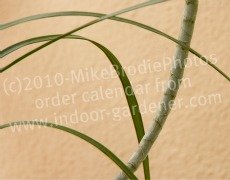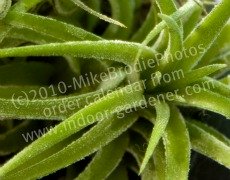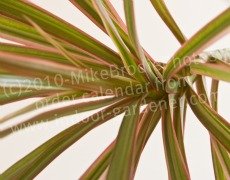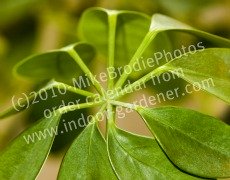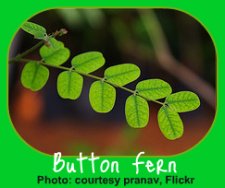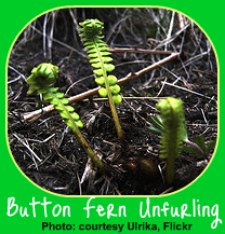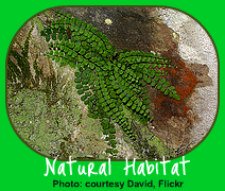Button Fern
a.k.a., Cliff Brake - Round-Leafed Fern - Tarawera
Pellaea rotundifolia
The Button Fern can be successfully grown by a patient beginner or an intermediate Indoor Gardener willing to pay attention while it establishes itself in new surroundings.
Once settled in, this is an easy-going fern, needing less care than many of its delicate, lacy relatives.
Very small, round, leathery leaves with a slight sheen to them grow along thin stems.
The branches stretch to only about a foot long with a slight, gentle arch to them. They grow quickly but stay small; you won't need anything larger than a 6- to 8-inch pot.
If happy, it can surprise its Indoor Gardener with up to 12 fronds curling up through the soil at once, usually in spring.
As it ages it changes: the leaflets become more oval-shaped; the stems turn a dark red; the arches grow more pronounced; and spores appear.
If the plant gets raggedy, you can trim back old growth down to the crown; you can also trim back any brown stem ends.
Also called the Cliff Brake, the Button Fern naturally grows on limestone cliffs and rock faces. Even as a houseplant, it prefers to dry out a bit between waterings and likes less misting than other ferns. If you do grow other ferns, keep this one on a different care schedule.
Finding the best water balance will be the tricky part. How often you water the Button Fern depends on the soil mix, the type of container (plastic, terracotta, ceramic), the season, the amount and kind of light, drainage, and the temperature and humidity of your home. As long as you don't over-water the Button Fern, you have a bit of leeway to experiment. Watch the tips of the fronds - if they're green, keep doing what you're doing!
Be careful not to confuse the Button Fern with the Lemon Button Fern - they look quite a bit alike from a distance but have a different taxonomy, origin, and very different care needs.
Click here to read our Disclosure Statement.
If you're serious about growing ferns - or someone you know is - a membership and subscription to the American Fern Society
and their magazine is almost essential. Keep up with new varieties to grow, techniques for planting, and how to maintain health for your ferns. The magazine provides info for both indoor and outdoor enthusiasts.
For the Indoor Gardener
CARE / SPECIAL NEEDS
The Button Fern is a little tricky in its needs, so try one pattern of care, watch your plant, and try something else if it doesn't look happy. Brown tips mean it needs more humidity.
Sources differ on the amount of light needed, how to water, misting, amount of humidity, dryness of soil, even soil mix - which is unusual. The only thing that seems to kill it quickly is a soggy root system, so be sure the soil is dry enough before you water again.
Otherwise, it'll try to hang in there with you until you figure out what your fern needs.
- LIGHT: indirect, bright light, especially in winter; more subdued light in summer
- WATER: moderate; warm; never let it stay soggy; wait until soil's dry before watering
- SOIL: well-draining soil and peat moss; some sources add sand
- HUMIDITY: moderate; use damp stone tray
- MISTING: sources say everything from no to occasionally to frequently; watch your plant's reactions
- FERTILIZER: spring-summer weekly; water soluble, half strength
- TEMP: normal room temperature; can tolerate a little cooler air than other ferns; avoid drafts
MAXIMUM DIMENSIONS
- HEIGHT: 8-12 inches
- WIDTH: a bit over 12 inches
HEALTH:
- scale (rare)
- some sources mention mealy bugs, aphids, thrip
- repot in spring; use well-draining shallow container
COST: inexpensive for young plants
PROPAGATION
- Spores: on older plants only
- Division
FLOWERS: None
FRIENDLINESS FACTOR: Sweet
Once you've negotiated a successful care program with your particular Button Fern in your particular home, the plant becomes a very pretty, easy-to-care-for addition to any Indoor Gardener's collection.
The Pallaea rotundifolia did not show up on any toxic-to-pets list consulted.
CONVERSATION VALUE: High
The combination of dainty looking but leathery leaves makes the Button Fern interesting. One of the smaller ferns who's very happy being the center of attention, it's quite the show-off once it's settled into a proper care pattern. In spring, it can shoot up to a dozen new fronds from the soil at once.
DECORATION SUGGESTIONS:
- Small hanging basket
- 6- to 8-inch pot
- Some success as a terrarium plant
For Botanists, Scientists,
Outdoor Gardeners,
and School Reports
ORIGIN: New Zealand (temperate forests)
Some sources add: Australia, North America, Asia, Africa, Norfolk Island, Madagascar
NATURAL GROWTH (OUTDOORS)
- cliffs and rocks - "cliff brake"
- especially limestone cliffs
- perennial
CATEGORIZATION:
Pallaea Rotundifolia
KINGDOM: Plantae
SUBKINGDOM: Tracheobionta (Vascular plants)
DIVISION: Pteridophyta
CLASS: Filicopsida
ORDER: Polypodiales
FAMILY: Pteridaceae (some sources: Sinopteridaceae or Adiantaceae)
GENUS: Pellaea
SPECIES: rotundifolia
DISCLAIMER: Indoor-Gardener.com reports information from research and does not guarantee any of the plants mentioned, for medicinal, decorative, or other uses. Neither the FDA nor any physician have endorsed the uses of plants mentioned on the website. Use plants as food or medicinal products only at your own risk.
Back to Top of Page
Return from Button Fern to
Indoor Gardener Home Page
